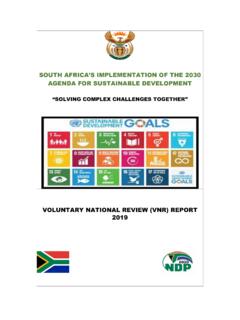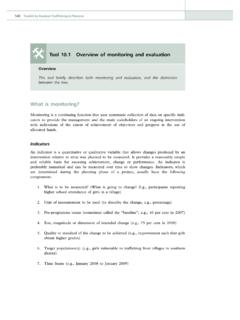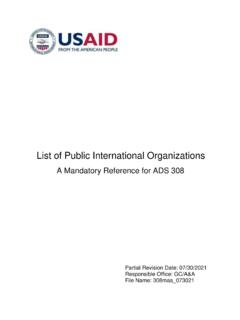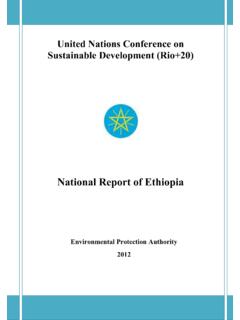Transcription of Community-based Agricultural Support Project (CASP)
1 Document Date: 15-May 2017 Project No. 2000001284 Report No: 4515-TJ Near East, North Africa and Europe Division programme Management Department Republic of Tajikistan Community-based Agricultural Support Project (CASP) Final Project design report Main report and appendices Republic of Tajikistan Community-based Agricultural Support Project (CASP) Final Project design report i Contents Currency equivalents iii Weights and measures iii Abbreviations and acronyms iv Map of the Project area vii Executive Summary viii Results Framework xii I. Strategic context and rationale 1 Country and rural development context 1 A. Rationale 8 Project description 10 Project area and target group 10 A. development objective and impact indicators 10 B. Outcomes/Components 10 C. Lessons learned and adherence to IFAD policies 17 Project implementation 19 Approach 19 A. Organizational framework 20 B. Planning, M&E, learning and knowledge management 26 C.
2 Financial management, procurement and governance 28 D. Supervision 30 E. Risk identification and mitigation 30 Project costs, financing, benefits and sustainability 31 Project costs 31 A. Project financing 32 B. Summary benefits and economic analysis 35 C. Sustainability 36 D. List of Figures Figure 1: Vulnerability map for Tajikistan (10 agro ecological zones) 43 List of Tables Table 1: Source of monetary income of an average rural household (per person per month) 5 Table 2: Project Costs by Components 32 Table 3: Financing Plan by Components including contingencies ( 000 US$) 33 Table 4: Expenditure Accounts by financier ( 000 US$) 34 Republic of Tajikistan Community-based Agricultural Support Project (CASP) Final Project design report ii Appendices Appendix 1: Country and rural context background 39 Appendix 2: Poverty, targeting and gender 47 Appendix 3: Country performance and lessons learned 59 Appendix 4: Detailed Project description 63 Appendix 5: Institutional aspects and implementation arrangements 79 Appendix 6: Planning, M&E and learning and knowledge management 113 Appendix 7: Financial management and disbursement arrangements 117 Appendix 8: Procurement 127 Appendix 9.
3 Project cost and financing 135 Appendix 10: Economic and Financial Analysis 141 Appendix 11: Draft Project implementation manual 169 Appendix 12: Compliance with IFAD policies 171 Appendix 13: Contents of the Project Life File 173 Republic of Tajikistan Community-based Agricultural Support Project (CASP) Final Project design report iii Currency equivalents Currency Unit = US$ = Weights and measures 1 kilogram = 1000 g 1 000 kg = lb. 1 kilometre (km) = mile 1 metre = yards 1 square metre = square feet 1 acre = hectare 1 hectare = acres Republic of Tajikistan Community-based Agricultural Support Project (CASP) Final Project design report iv Abbreviations and acronyms ADB Asian development Bank AKF Aga Khan Foundation AMSC ASAP Agricultural Mechanization Service Centre Adaptation for Smallholder Agriculture programme ATAC AWPB BDS CACILM Agriculture Training and Advisory Centre Annual Work Plan and Budget Business development Services Central Asian Countries Initiative on Land Management CARITAS CC CDF CDS Catholic Agency for Overseas Aid and development Climate Change Community development Funds Community development Specialist CF CGA CIF Community Facilitator Community Grant Agreement Climate Investment Funds CIG Common Interest Group CIS Commonwealth of Independent States CLPMP CN CO DCC DDC DFID DPO Community Livestock and Pasture Management Plan Concept Note Community Organization Donor Coordination Council District development Committees Department for International development (United Kingdom)
4 District Project Officer EAEU EBRD Eurasian Economic Union European Bank for reconstruction and development ECA EC Europe and Central Asia European Commission EIU ERR FAO Economist Intelligent Unit Economic Internal Rate of Return Food and Agriculture Organization of the United Nations FHH FIRR FM FSU GAO GAP GDI GDP GIZ GNI GOT HDI HH ICARDA IDA IFAD IGA IMF INGO Female Headed Household Financial Internal Rate of Return Financial Management Former Soviet Union Gross Agricultural Output Gender Action Plan Gender development Index Gross Domestic Product German International Cooperation Gross National Income Government of Tajikistan Human development Index Household International Center for Agricultural Research in the Dry Areas International development Association International fund for Agricultural development Income Generating Activity International Monetary fund International Non-Governmental Organisation Republic of Tajikistan Community-based Agricultural Support Project (CASP) Final Project design report v IRR Internal Rate of Return JC JCSS KM KLSP LPDP Jamoat Council Joint Country Support Strategy Knowledge Management Khatlon Livelihoods Support Project Livestock and Pasture development Project LU M&E MFI MIS MOA MOF Livestock Unit (equal to one adult sheep) Monitoring and Evaluation Microfinance Institution Management Information System Ministry of Agriculture Ministry of Finance MOU MSDSP Memorandum of Understanding Mountain Societies development Support programme Mt NAAS NBT NDS NGO NPV PAR PIM PMU PPP Metric ton National Academy of Agricultural Sciences National Bank of Tajikistan National development Strategy Non-Governmental Organisation Net Present Value Portfolio at risk Project Implementation Manual Project Management Unit Purchasing Power Parity PRS(P) PSC PUU PUUB PY RIMS Poverty Reduction Strategy (Paper)
5 Project Steering Committee Pasture Users Union PUU Board Project Year Results and Impact Management System RRS SCLMG SCF SCISPM SDC SDR SIDA SME Somoni SWOT TA TAU TLSS ToT TOR Rayons of Republican Subordination State Committee for Land Management and Geodesy Strategic Climate fund State Committee on Investments and State Property Management Swiss development Cooperation Special Drawing Right(s) Swedish International development Agency Small and Medium Enterprises Local currency Strengths, Weaknesses, Opportunities and Threats Technical Assistance Tajik Agrarian University Tajikistan Living Standards Survey Training of Trainers Terms of Reference UNDP USAID US$ United Nations development programme United States Agency for International development United States Dollar VO WB Village Organization World Bank WFP World Food programme WG Women Group Republic of Tajikistan Community-based Agricultural Support Project (CASP) Final Project design report vi Definitions and Glossary Smallholder farmers Smallholder farmers refer to those with small sizes of Agricultural land that rely mainly on family labour.
6 In Tajikistan, smallholder farmers usually have access to small plots ( ha) for crops near the homestead (often called kitchen gardens ), over which they have a permanent and heritable use right. Some of them might have received additional small plots, commonly called Presidential Lands . In addition to those crop lands, smallholder farmers would have access to communal pasture land for grazing animals. Dehkan farms Dehkan farms are run by private persons at individual, family or collective levels. The size of dehkan farms varies from five to thousands of hectares. Family and collective dehkan farms appoint a head who officially holds the farm s land registration certificate and legally represents the interests of the farm. Many large collective dehkan farms, however, continue to operate as collective or state farms. Village Organizations Village Organizations (VOs) are the Community-based organizations at the village level.
7 Initially started with Support from the Mountain Societies development Support programme (MSDSP) of the Aga Khan Foundation, creating a grassroots organizational entity to represent the village community, VOs gained momentum and their numbers have increased sharply. The VO concept and functions have been mainstreamed, and VOs currently have a legal status under the Law on Public Self-Initiative Bodies and cover basically all the country. VOs are recognized bodies by both the government and donors as focal points for linking and working with communities though are underfunded and in some cases have week governance. Mahalla Mahalla means a traditional forum of self-governance at the neighbourhood community level. Traditionally, it was governed by a council of elders. Mahalla in its current usage is understood as a social unit/community with mechanisms of self-governance. Jamoat Jamoats are the third-level administrative divisions (below district or rayon) in Tajikistan or sub-districts.
8 There are about 406 Jamoats in the country. Hukumat Hukumat refers to a local government/state administration. Hukumats operate at region and district levels. Republic of Tajikistan Community-based Agricultural Support Project (CASP) Final Project design report vii Map of the Project area Republic of Tajikistan Community-based Agricultural Support Project (CASP) Final Project design report viii Executive Summary Country context and sectoral strategy Tajikistan is a landlocked country bordering Afghanistan in the south, China in the east, Kyrgyzstan in the north, and Uzbekistan in the west. The country s population reached million people in 2015. The country has one of the lowest per capita GDPs among the 15 former Soviet republics. The gross national income (GNI) per capita (Atlas method, current US$) was estimated at US$ 1,280 in 2015. The country has a narrow economic base dominated by the production of aluminium and cotton, the two main export commodities, supplemented by remittances from Tajik nationals working abroad.
9 5. Agriculture is a major component of the Tajik economy. In 2015 it accounted for 25% of GDP and it plays a significant role in the rural population s livelihood and food security. In 2015 agriculture employed 45% of the workforce, according to government statistics. Despite its critical importance, the Agricultural resource base is characterized by limited arable land. The Agricultural sector is in general characterized by poor efficiency and productivity and incomes are low. Key factors that limit development include lack of access to: finance, modern Agricultural machinery and equipment, modern technologies and farming practices, and agro-services. Tajikistan was one of the poorest members of the former USSR and after independence poverty increased sharply as a result of an abrupt termination of economic Support from the Soviet Union and an extended civil war after independence in 1991, derailing all economic activity.
10 However, progress has been made as available data show that poverty declined from 81% in 1999 to about 32% in 2014. One fifth of the population in Tajikistan is affected by food insecurity. The incidence of poverty is above average in rural areas ( ) which host over 80% of the total poor. The productivity of the Agricultural sector is significantly constrained by the limited access to Agricultural machinery and equipment, services for operation and maintenance for the existing equipment. The inventory of Agricultural machinery was largely destroyed during the civil war in the 1990 s together with the related service infrastructure. Investments in Agricultural machinery resumed in 2000, but at a very narrow pace and scale due to limited access to finance. By and large, the Agricultural mechanization condition in Tajikistan is considered responsible for lowering crop productivity by 20% and in worst cases by 30%. Reasons behind this comprise improper and untimely land preparation and seeding planning, inadequate land operations, and low performing harvestings.










